The ADATA XPG SX6000 Pro 1TB SSD Review: Realtek's Entry-level NVMe Solution
by Billy Tallis on December 18, 2019 12:30 PM ESTRandom Read Performance
Our first test of random read performance uses very short bursts of operations issued one at a time with no queuing. The drives are given enough idle time between bursts to yield an overall duty cycle of 20%, so thermal throttling is impossible. Each burst consists of a total of 32MB of 4kB random reads, from a 16GB span of the disk. The total data read is 1GB.

The burst random read performance from the ADATA XPG SX6000 Pro is rather disappointing considering what drives with Silicon Motion controllers get out of the same NAND, but at least it's still a bit faster than the Crucial MX500 SATA drive that also uses Micron 64L TLC.
Our sustained random read performance is similar to the random read test from our 2015 test suite: queue depths from 1 to 32 are tested, and the average performance and power efficiency across QD1, QD2 and QD4 are reported as the primary scores. Each queue depth is tested for one minute or 32GB of data transferred, whichever is shorter. After each queue depth is tested, the drive is given up to one minute to cool off so that the higher queue depths are unlikely to be affected by accumulated heat build-up. The individual read operations are again 4kB, and cover a 64GB span of the drive.
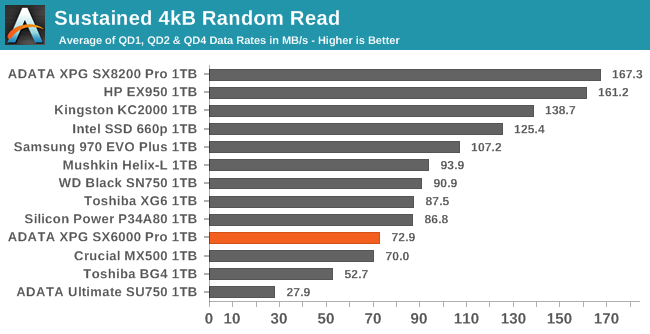
The SX6000 Pro ranks about the same on the longer random read test, but this level of performance is more expected here given that it's a DRAMless SSD. However, the Mushkin Helix-L is in the same boat and still manages to be 28% faster.
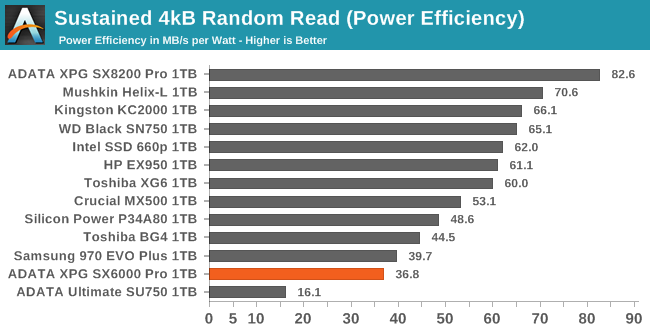 |
|||||||||
| Power Efficiency in MB/s/W | Average Power in W | ||||||||
Realtek's SSD controllers are still in last place for power efficiency, but the efficiency score for the SX6000 Pro is only a bit worse than for the Samsung 970 EVO Plus. The power draw of just under 2W is in the normal range for NVMe SSDs in general, but the other low-end drives draw closer to 1W.
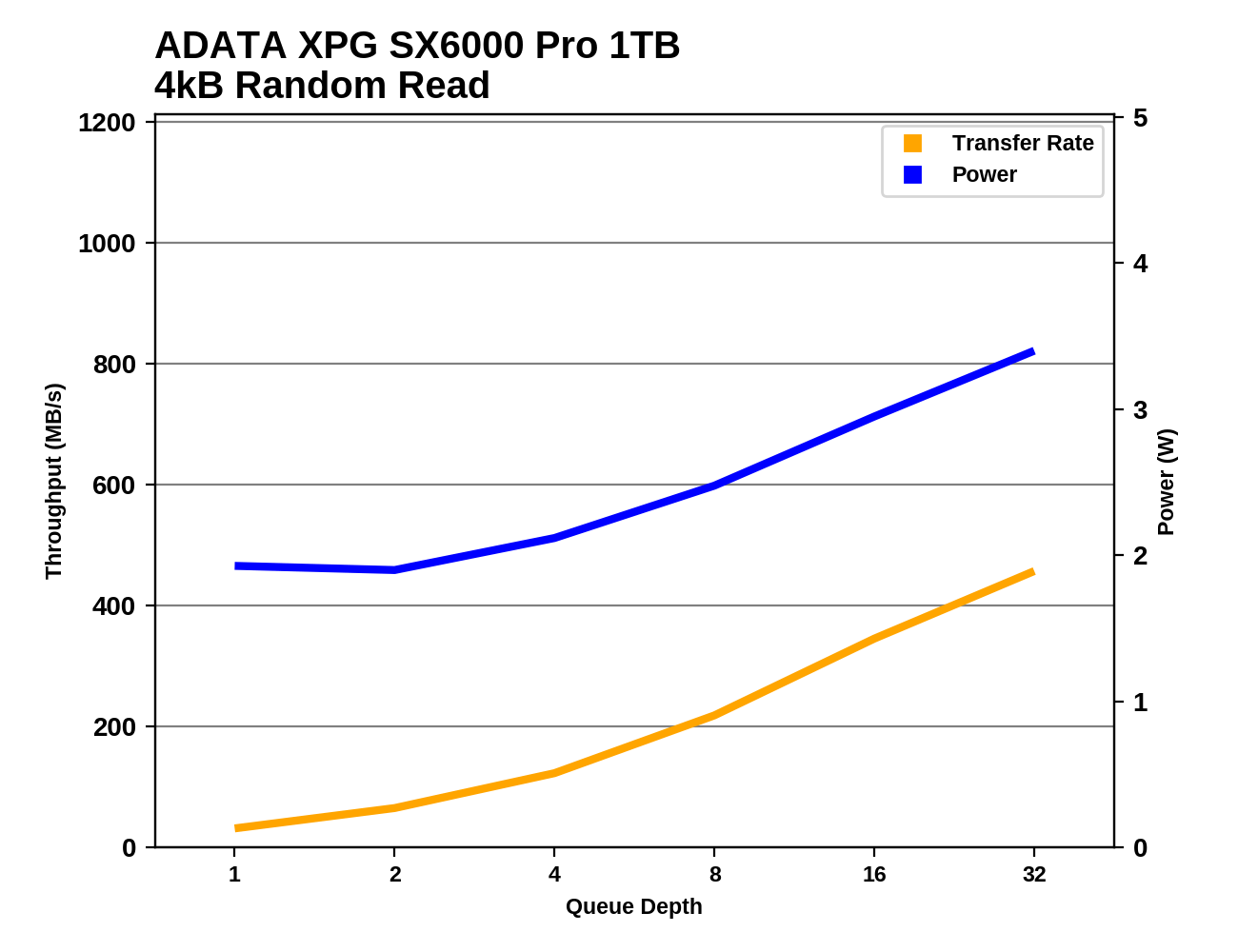 |
|||||||||
The random read performance of the SX6000 Pro starts out slow at QD1 but it scales up reasonably well for a 4-channel controller. Unfortunately, power consumption also scales up, so even at higher queue depths it is still relatively inefficient.
With a high enough queue depth, the random read performance of the SX6000 Pro does climb out of SATA territory, but not by much. It definitely draws more power than most drives across the entire range of tested queue depths, but isn't quite record-setting.
Random Write Performance
Our test of random write burst performance is structured similarly to the random read burst test, but each burst is only 4MB and the total test length is 128MB. The 4kB random write operations are distributed over a 16GB span of the drive, and the operations are issued one at a time with no queuing.

The burst random write performance of the SX6000 Pro is way above what the SATA drives manage, but is on the low side by NVMe standards—even when considering just the low-end NVMe drives.
As with the sustained random read test, our sustained 4kB random write test runs for up to one minute or 32GB per queue depth, covering a 64GB span of the drive and giving the drive up to 1 minute of idle time between queue depths to allow for write caches to be flushed and for the drive to cool down.
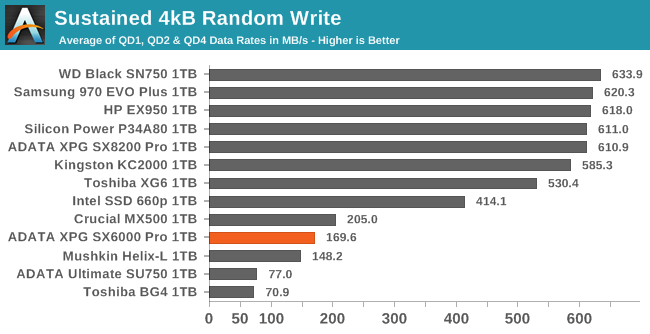
On the longer random write test, the SX6000 Pro falls far behind the high-end NVMe drives and is a bit slower than the Crucial MX500 SATA SSD. The SX6000 Pro is the fastest of the DRAMless drives in this bunch, but the Intel 660p's strategy of using QLC NAND with DRAM makes it by far the fastest low-end NVMe drive on this test.
 |
|||||||||
| Power Efficiency in MB/s/W | Average Power in W | ||||||||
The SX6000 Pro is the fastest DRAMless drive on this test, but it's also by far the most power-hungry, so its efficiency score is significantly worse than that of the Mushkin Helix-L.
 |
|||||||||
Performance and power consumption from the SX6000 Pro are unsteady throughout the random write test, but the overall trend is flat. That plus the fact that lower performance corresponds to higher power consumption shows that the drive is bottlenecked by background work, and it needs more idle time than this test provides.
Since the SX6000 Pro's SLC cache is far less effective for random writes than sequential, and it is slow about completing background maintenance, the drive is stuck firmly in SATA performance territory with power efficiency that is mediocre at best.


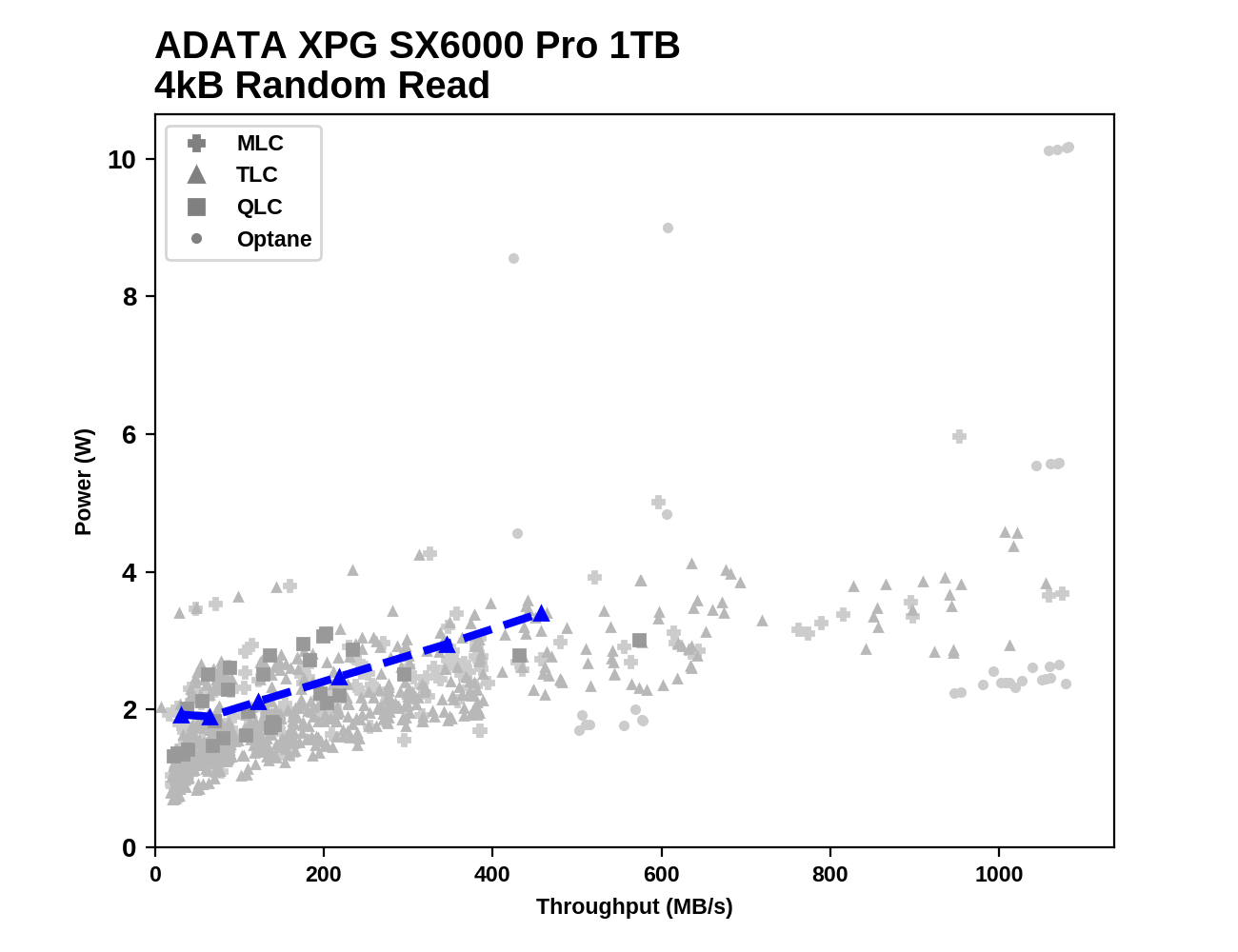









36 Comments
View All Comments
Samus - Wednesday, December 18, 2019 - link
I don’t think you are being critical enough of this drive. It is appallingly bad. It’s basically outclassed by SATA drives from years ago in almost every metric except sequential performance (where NVMe will naturally excel)But real world performance is terrible, power usage is high (and it has broken devsleep) and it isn’t very cheap. When you consider reliability is a total u known I’m struggling to imagine a single person who would consider this.
Billy Tallis - Wednesday, December 18, 2019 - link
Let me make it a bit clearer for you: https://www.anandtech.com/bench/product/2533?vs=22...The MX500 beats the SX6000 Pro on just ONE of those performance metrics. The picture's not that different if you compare against a Samsung SATA drive. Overall performance is clearly much better than a SATA SSD. It's not appallingly bad. It just isn't a high-end NVMe drive.
DPUser - Wednesday, December 18, 2019 - link
Appallingly Clearer. : )Alistair - Wednesday, December 18, 2019 - link
haha nice :)JoeyJoJo123 - Wednesday, December 18, 2019 - link
Based Billy Tallis *dabbing* on the n00bs in the comments section. FACTS don't care about your feelings, Samus. It's times like this I'm glad you can't edit your comments, since moments like these are eternalized forever.MFinn3333 - Wednesday, December 18, 2019 - link
To be fair, the Samsung 850 Pro does beat it in the sustained random read/writes, power efficiency of said read/writes and uses a lot less power while active idle.https://www.anandtech.com/bench/product/2310?vs=25...
(Blue is Samsung and Orange is ADATA because Samsung is blue in my mind).
To be fairer, the Samsung is at least five years old, costs three times as much if you can get it, and has an idle response that is 15X worse than the ADATA. The ADATA is clearly the better drive for 99% of the population.
The_Assimilator - Wednesday, December 18, 2019 - link
It's absolutely appallingly bad. You can't simply excuse broken power management with "the other vendors messed it up too", the point is that none of those other vendors have messed it up NOW. Realtek failed to learn from and avoid their competitors' mistake, and by doing so have introduced their controller with a handicap versus the same competitors. It's also both unproven, slower, and more expensive than older controllers that do have a known track record, so that's four strikes against the RTS5763DL.In contrast, drives using the two-year-old SM2263XT are faster, cheaper, and to be blunt, just better. There is thus no reason why anybody would ever choose a drive using RTS5763DL, and its complete failure to compete is only going to become more apparent once the next-gen SMI and Phison controllers arrive (and E12 products go EOL and get huge discounts).
In short, while not as bad as Realtek's attempt at a SATA SSD controller, the RTS5763DL is just a plain bad product that simply cannot be recommended in any way shape or form.
milli - Wednesday, December 18, 2019 - link
Well look at this one again then: https://images.anandtech.com/graphs/graph15139/sus...I've learned from real-life usage that this test is one of the most important metrics that you will notice in your day to day usage. The Realtek is by far the fastest cacheless NVMe controller out there in this test.
Also while the drive lacks DEVSLP, statements like "broken power management" are just false. The graphs clearly show that it cuts power in half in each state. Lacking DEVSLP does not equal broken power management. ADATA even clearly states this on their website.
gregassagraf - Wednesday, July 21, 2021 - link
well... I installed the xpg Gammix s41 which is based in the same microcontroller! I lost more than an hour of battery life in my laptop and now sleep mode is basically useless. One big mistake in my part was caring only about read and write speeds. I can't wait to replace this drive, its driving me mad!mark625 - Wednesday, December 18, 2019 - link
The HP EX950 1TB has been my favorite value/$ drive for a while, and it costs a whole $7 more than the SX6000 Pro. It whomps the XPG drive in almost every test, and in many tests it is more than twice as fast.In what possible scenario would the XPG drive be a smarter purchase than the HP? None that I can see. This review is way too forgiving.